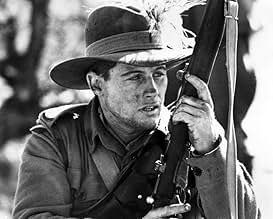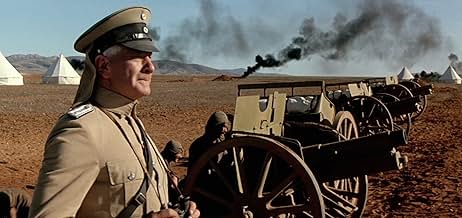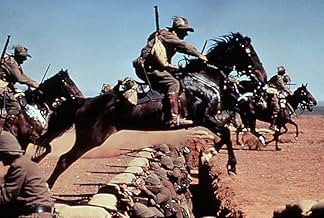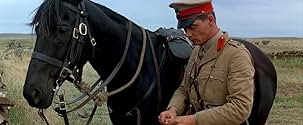VALUTAZIONE IMDb
6,8/10
2171
LA TUA VALUTAZIONE
Aggiungi una trama nella tua linguaIn 1917 when the British forces are bogged down in front of the Turkish and German lines in Palestine they rely on the Australian light horse regiment to break the deadlock.In 1917 when the British forces are bogged down in front of the Turkish and German lines in Palestine they rely on the Australian light horse regiment to break the deadlock.In 1917 when the British forces are bogged down in front of the Turkish and German lines in Palestine they rely on the Australian light horse regiment to break the deadlock.
- Regia
- Sceneggiatura
- Star
- Premi
- 2 vittorie e 1 candidatura in totale
Jack Heywood
- Dave's Dad
- (as John Heywood)
Recensioni in evidenza
Historically accurate and meticulously researched, this is one of the genre of "federation-era" war productions in the 1980's by the Australian film industry. The high-quality movies and mini-series of this collection included such titles as "Breaker Morant", "Gallipoli" and "ANZACS", and one can see obvious similarities in the techniques and methodology used in their production. This, however, does not detract from their appeal or their entertainment value; quite the reverse, in fact. The formula for this genre was to take an historically-documented campaign and translate it as faithfully as possible to the big screen, with emphasis on characterisation, accuracy of detail and background.
The formula works, because the characters are believable, and the situations, events and settings have been faithfully re-created. Much of the background and information for this genre came from personal diaries and military archives preserved over the years, which adds credence to the plots, the action and the stories.
"The Lighthorsemen" highlights the campaign of the Australian mounted rifles in the North Africa battleground of the Great War, and culminates with the last successful action of horse-riding troops in combat. Without giving away the story too much, the taking of Beersheba in the closing days of 1918 was a decisive event in military history, and the screen portrayal of this action will have you on the edge of your seat.
Masterful performances by Jon Blake, Shane Briant and Bill Kerr (all veterans of this movie formula,) the attention to detail, the drama, and the occasional humour make for a very entertaining movie. It's recommended viewing.
The formula works, because the characters are believable, and the situations, events and settings have been faithfully re-created. Much of the background and information for this genre came from personal diaries and military archives preserved over the years, which adds credence to the plots, the action and the stories.
"The Lighthorsemen" highlights the campaign of the Australian mounted rifles in the North Africa battleground of the Great War, and culminates with the last successful action of horse-riding troops in combat. Without giving away the story too much, the taking of Beersheba in the closing days of 1918 was a decisive event in military history, and the screen portrayal of this action will have you on the edge of your seat.
Masterful performances by Jon Blake, Shane Briant and Bill Kerr (all veterans of this movie formula,) the attention to detail, the drama, and the occasional humour make for a very entertaining movie. It's recommended viewing.
I have watched this movie at least five times. Initially, I was a little disappointed by the tedium of the first half of the movie. I began to realize, however, that the first half of the movie is a pretty good reflection of military life prior to the second half of the 20th century: long periods of boredom and routine punctuated by major confrontations.
I've noticed that a few reviewers have remarked on the final "cavalry charge," which suggests to me that they really weren't paying much attention to the movie. The final charge on the Turkish positions is so much more awe-inspiring given the usual tactics of the Lighthorsemen. One of the most thrilling moments is when the Aussies prepare to meet the enemy on horseback and, instead of pulling out the classic cavalrymen's sabers, draw their bayonets for the charge. You almost want to laugh at the sight of 16" knives against the well-emplaced Turks.
This is one of the few war movies based on actual events that is fairly accurate, too. Take a look at some of the sites dedicated to the 4th Light Horse Briagde and you will see what I mean. A letter from one of the actual participants to his brother is an almost perfect description of the events as shown in the movie.
**** out of ***** if only for the charge
I've noticed that a few reviewers have remarked on the final "cavalry charge," which suggests to me that they really weren't paying much attention to the movie. The final charge on the Turkish positions is so much more awe-inspiring given the usual tactics of the Lighthorsemen. One of the most thrilling moments is when the Aussies prepare to meet the enemy on horseback and, instead of pulling out the classic cavalrymen's sabers, draw their bayonets for the charge. You almost want to laugh at the sight of 16" knives against the well-emplaced Turks.
This is one of the few war movies based on actual events that is fairly accurate, too. Take a look at some of the sites dedicated to the 4th Light Horse Briagde and you will see what I mean. A letter from one of the actual participants to his brother is an almost perfect description of the events as shown in the movie.
**** out of ***** if only for the charge
This is a story about some episode British-Turk campaign in Palestine in 1917. Very important role in this campaign was played by Australian forces. The key to conquer the Holy Land is city of Gaza. British general wants however to throw his forces to bypass the city and capture another one - Beersheba. To take them both it is necessary to keep his plan secret.
As a person who is interested in all WWI history I was waiting for this movie. I find it very good. All equipment seems to be very accurate, however, I've never heard about use of tanks in this front. There is a nice scene of air attack by German biplane, cars from that times, uniforms, and so on -- it all seems to be historical correct. The final charge is worth waiting for. I think that anyone who is interested in this campaign would be satisfied.
Because of Australian point of view the role of British army seems to be a little underrated. I especially mean British commander -- general Allenby. I think it would be good to say at the very end that after capturing Beersheba, Gaza fell as well a week later, and the road to Jerusalem was opened. This was what was lacking for me.
As a person who is interested in all WWI history I was waiting for this movie. I find it very good. All equipment seems to be very accurate, however, I've never heard about use of tanks in this front. There is a nice scene of air attack by German biplane, cars from that times, uniforms, and so on -- it all seems to be historical correct. The final charge is worth waiting for. I think that anyone who is interested in this campaign would be satisfied.
Because of Australian point of view the role of British army seems to be a little underrated. I especially mean British commander -- general Allenby. I think it would be good to say at the very end that after capturing Beersheba, Gaza fell as well a week later, and the road to Jerusalem was opened. This was what was lacking for me.
This is an excellent film with surely the finest cavalry charge ever filmed. In this movie the horse is King and the care taken to illustrate the vital interaction between these magnificent animals and their riders is great to behold. The acting and direction are good without the need for big names. It has had a number of releases, the best being a 2.35 wide screen laser disc version in the USA. Australia has released a DVD version but it is dreadfully truncated being cut to 1.78 from the vastly more meaningful aspect ratio of the laser disc. On the big screen this film makes a fantastic impact and every effort should be made to see the original wide screen version in this way. Highly recommended.
A First World War Australian cavalry -- sorry, mounted infantry -- film set in the Holy Land, that's not something one tends to see every day. So, for me, the fact that, yes, the characters and situations can be a little clichéd at times is far outweighed by the novelty of the whole scenario. Quibbles are easy to put to one side.
The cavalry distinction is important. Cavalry would be armed with carbines and sabres. Mounted infantry have rifles and dismount in order to fight. This subtlety plays a part in the outcome.
A series of small skirmishes heightens tension within the film until the exciting finale, when there is a fantastic, large scale, cav ... mounted infantry charge which got my pulse racing. You'll recall something similar in David Lean's "Lawrence of Arabia". This set piece is bigger. Johnny Turk was the villain that time too.
This being an Australian Imperial Force meets the British Army sort of film, there is bound to be a little Pommy-bashing going 'round. When I lived briefly in Australia a decade ago, I found Pommy-bashing to be the single unattractive facet to the Australian national character. (The Kiwis don't do it. We like Poms here too. Pity the Dominions can't agree on that one.) So while some of the Poms in this film might be a few sheep short of a paddock, still there *is* balance, with one Pom who is much cleverer than the average. Bashing even works its way into the plot, a nice touch that.
The film does not use an excessive amount of Strine lingo -- billy, tucker -- so very little acclimatization is necessary for the uninitiated.
I can't vouch for the overall authenticity of this film. But I did notice that campaign map in the Turkish commander's office. It's labelled in Arabic only. Egypt is identified as "Misr". Geez, that is the correct Arabic name. And the Ottomans were still using the Arabic alphabet at the time. (It's Atatürk after the war who switched Turkish over to the Roman alphabet.) The thing's fair dinkum, mate. If they cared enough to get details like that right, then I'm sure that says a lot about the effort put into the film as a whole.
There is an earlier Australian film about the Light Horse I'd like to see, "Forty Thousand Horsemen" from 1940 or '41 (sources differ). Finding a copy of that film in this hemisphere though would be extraordinary, a bit like finding a North American who likes Vegemite.
The cavalry distinction is important. Cavalry would be armed with carbines and sabres. Mounted infantry have rifles and dismount in order to fight. This subtlety plays a part in the outcome.
A series of small skirmishes heightens tension within the film until the exciting finale, when there is a fantastic, large scale, cav ... mounted infantry charge which got my pulse racing. You'll recall something similar in David Lean's "Lawrence of Arabia". This set piece is bigger. Johnny Turk was the villain that time too.
This being an Australian Imperial Force meets the British Army sort of film, there is bound to be a little Pommy-bashing going 'round. When I lived briefly in Australia a decade ago, I found Pommy-bashing to be the single unattractive facet to the Australian national character. (The Kiwis don't do it. We like Poms here too. Pity the Dominions can't agree on that one.) So while some of the Poms in this film might be a few sheep short of a paddock, still there *is* balance, with one Pom who is much cleverer than the average. Bashing even works its way into the plot, a nice touch that.
The film does not use an excessive amount of Strine lingo -- billy, tucker -- so very little acclimatization is necessary for the uninitiated.
I can't vouch for the overall authenticity of this film. But I did notice that campaign map in the Turkish commander's office. It's labelled in Arabic only. Egypt is identified as "Misr". Geez, that is the correct Arabic name. And the Ottomans were still using the Arabic alphabet at the time. (It's Atatürk after the war who switched Turkish over to the Roman alphabet.) The thing's fair dinkum, mate. If they cared enough to get details like that right, then I'm sure that says a lot about the effort put into the film as a whole.
There is an earlier Australian film about the Light Horse I'd like to see, "Forty Thousand Horsemen" from 1940 or '41 (sources differ). Finding a copy of that film in this hemisphere though would be extraordinary, a bit like finding a North American who likes Vegemite.
Lo sapevi?
- QuizWebsite Cinephilia reports of the Jon Blake accident and legal case: "Jon Blake was critically injured whilst driving home on December 1, 1986, after the final day's filming of The Lighthorsemen - Attacco nel deserto (1987). He sustained severe brain injuries and in December, 1995, the New South Wales Supreme Court ruled that Blake should be compensated for the loss of potential earnings as a star in the United States. After taking evidence from actors, directors, and film critics who indicated his career could have been as big as Mel Gibson's, the court awarded him $32 million in damages. This was later reduced to $7 million after the defence appealed."
- BlooperAt the rest camp just after the 2 soldiers pass the British Major and addresses the Colonel about the men wearing shorts at the end the Colonel calls the Major 'Sir', this wouldn't happen as a Colonel is a higher rank to Major.
- Versioni alternativeUK versions are cut by 6 secs to remove cruel horsefalls.
- ConnessioniEdited into Le avventure del giovane Indiana Jones: Palestine, October 1917 (1993)
- Colonne sonoreAUSTRALIA WILL BE THERE
Music and lyrics by W.W. 'Skipper' Francis
By Arrangement with Allans Music (Australia) Pty. Limited
I più visti
Accedi per valutare e creare un elenco di titoli salvati per ottenere consigli personalizzati
- How long is The Lighthorsemen?Powered by Alexa
Dettagli
- Data di uscita
- Paese di origine
- Siti ufficiali
- Lingua
- Celebre anche come
- The Lighthorsemen
- Luoghi delle riprese
- St. Kilda, Melbourne, Victoria, Australia(beach, Mediterranean Sea)
- Aziende produttrici
- Vedi altri crediti dell’azienda su IMDbPro
Botteghino
- Budget
- 10.500.000 A$ (previsto)
- Lordo Stati Uniti e Canada
- 33.779 USD
- Fine settimana di apertura Stati Uniti e Canada
- 23.645 USD
- 10 apr 1988
- Lordo in tutto il mondo
- 34.514 USD
- Tempo di esecuzione
- 2h 11min(131 min)
- Mix di suoni
- Proporzioni
- 2.35 : 1
Contribuisci a questa pagina
Suggerisci una modifica o aggiungi i contenuti mancanti
















